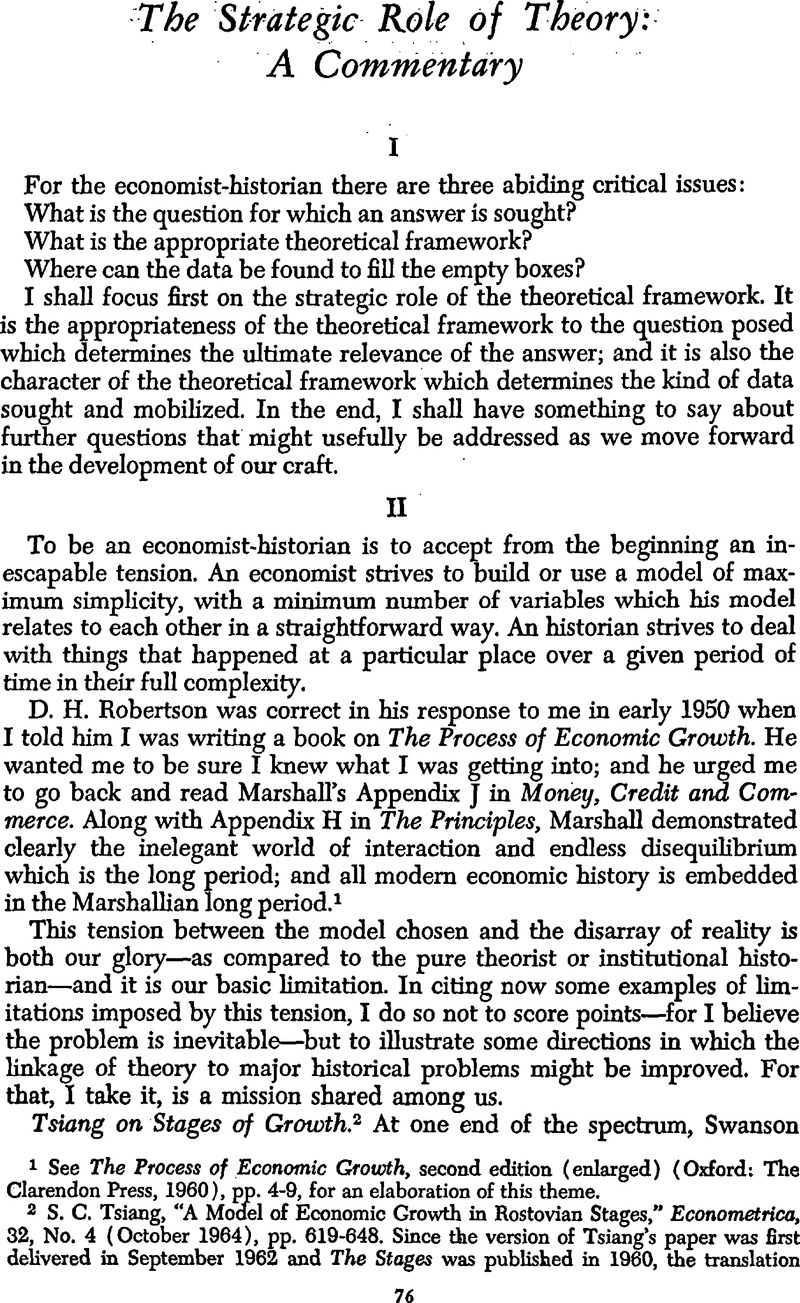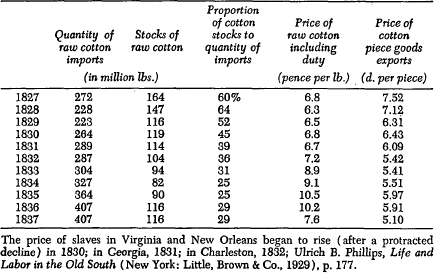No CrossRef data available.
Article contents
The Strategic Role of Theory: A Commentary
Published online by Cambridge University Press: 11 May 2010
Abstract

- Type
- Economic History: Retrospect and Prospect. Papers Presented at the Thirtieth Annual Meeting of the Economic History Association
- Information
- Copyright
- Copyright © The Economic History Association 1971
References
1 See The Process of Economic Growth, second edition (enlarged) (Oxford: The Clarendon Press, 1960), pp. 4–9Google Scholar, for an elaboration of this theme.
2 Tsiang, S. C., “A Model of Economic Growth in Rostovian Stages,” Econometrica, 32, No. 4 (October 1964), pp. 619–648CrossRefGoogle Scholar. Since the version of Tsiang's paper was first delivered in September 1962 and The Stages was published in 1960, the translation time-lag does not seem excessive. Tsiang notes (p. 620n.) that he was in fact working along the lines of his model from 1958. It is the kind of problem posed by Tsiang's model that Solow and I discuss in general in the Konstanz volume [ Rostow, W. W., editor, The Economics of Take-off into Sustained Growth (New York: St. Martin's Press, 1963), pp. 468–74Google Scholar. (Solow); pp. xxiv-xxvi (the author)].
3 David, Paul, “The Growth of Real Product in the United States before 1840: New Evidence, Controlled Conjectures,” The Journal. of Economic History, XXVII (June 1967), pp. 151–197CrossRefGoogle Scholar.
4 Rostow, W. W., “The Take-off into Self-Sustained Growth,” The Economic Journal, LXVI (March 1956), pp. 38–9Google Scholar.
5 François Crouzet makes essentially this distinction in comparing the relative expansion in Britain and France of the eighteenth century [“England and France in the Eighteenth Century: A Comparative Analysis of Two Economic Growths,” Chapter 7 in Hartwell, R. M., editor, The Causes of the Industrial Revolution in England (London: Methuen, 1967)]Google Scholar
6 Temin, Peter, “The Causes of Cotton-Price Fluctuations in the 1830's,” The Review of Economics and Statistics, XLIX, No. 4 (Nov. 1967)Google Scholar; also, The Jacksonian Economy (New York: W. W. Norton, 1969)Google Scholar.
7 See, notably, Gayer, A. D. et al. , The Growth and Fluctuation of the British Economy, 1790–1850, II (Oxford: Clarendon Press, 1953), pp. 563–65Google Scholar and pp. 792–94 on the behavior of wheat imports, whose fluctuations, with all their consequences for the state of the money market, represented one route for the impact of the British harvest on the state of the British economy as a whole. For relative rates of increase in British cotton exports and the American cotton crop, in relation to the raw cotton price, see Vol. II, pp. 838–841. For an account of the British economy as a whole in the 1830's, see Vol. I, Chapter V, pp. 242 ff.
8 Ibid., Vol. II, p. 688, and Vol. I, pp. 263–65. For the critical years of the 1830's here are the relevant annual data:

9 My essay on “The Terms of Trade in Practice” (The Process of Economic Growth, Chapter ix) deals at some length with the determinants of the cotton price in this period, pp. 201–205. And it seeks, in general, to specify the variables required for an econometric “explanation” of price movements.
10 In The Economics of Take-off into Sustained Growth (pp. 5–6), I defined lateral effects as follows:
… the leading sector will induce around it a whole set of changes which tend to reinforce the industrialization process on a wider front. Modem industrial activity surrounded itself with urban men, services, and institutions whose existence strengthened the foundations for industrialization as an ongoing process: a disciplined working force organized around the hierarchies decreed by technique; professional men to handle the problems of law and relations to the various markets for input and products; urban overhead capital; institutions of banking and commerce; and the construction and service industries required to meet the needs of those who manned the new industrial structure. The coming in of a new leading sector thus often transformed the whole region where it took hold; as, for example, the cotton textile revolution transformed Manchester and Boston and the automobile industry transformed Detroit. Wherever they went, the railroads induced the transformation of old urban centers or the creation of new ones, not merely for railroad maintenance but also to handle the marketing and commercial traffic that the railroads made possible and profitable. These lateral effects—symbolized by the acceleration in urbanization during take-off—expanded the proportion of modern folk in the total population and strengthened modern attitudes towards the production process far beyond the narrow impact of the new activity itself and the inputs it directly induced.
11 Fishlow, Albert, American Railroads and the Transformation of the Ante-Bellum Economy (Cambridge, Mass.: Harvard University Press, 1965), p. 16 nGoogle Scholar.
12 The proportion of urban to total population in the United States moved as follows from 1790 to 1860:

Data for 1790–1810 from Woytinsky, W. S. and Woytinsky, E. S., World Population and Production: Trends and Outlook (New York: The Twentieth Century Fund, 1853, p. 124Google Scholar; for 1820–1860 from Bergson, Abram and Kuznets, Simon, editors, Economic Trends in the Soviet Union (Cambridge, Mass.: Harvard University Press, 1963), p. 72CrossRefGoogle Scholar.
13 A. Fishlow, American Railroads, p. 261.
14 Ibid., p. 250.
15 A. D. Gayer, et al, Growth and Fluctuation, Vol. I, Chapter VI.
16 Rostow, w. w., British Economy of the Nineteenth Century (Oxford: Clarendon Press, 1948)Google Scholar, Chapters III, IV, and VII, especially pp. 60–61, 83–88, and 148–59. A more detailed examination of the issue is contained in my unpublished doctoral dissertation, British Trade Fluctuations, 1868–1896: A Chronicle and a Commentary, Yale University, 1939, especially pp. 471–487Google Scholar. For the same issues considered for the period 1815–1850, see A. D. Gayer, et al, Growth and Fluctuation, Vol. II, Chapters IV and V.
17 W. W. Rostow, British Economy of the Nineteenth Century, pp. 159–60.
18 Friedman, Milton and Schwartz, Anna Jacobson, A Monetary History of the United States, 1867–1900 (Princeton: Princeton University Press, 1963)Google Scholar.
19 In a letter to me of February 2, 1940, Keynes wrote (in connection with the initial publication of “Explanations of the Great Depression” in Economic History, 1940):
Reading about my own opinions as set forth in the Treatise does indeed feel like an historical exercisel One of the many elements which I entirely omitted then and certainly should stress now is the greatly increased volume of investment required to produce full employment, as the years went by after 1870, owing to the great growth in wealth. The opportunities for profitable investment have not merely to keep pace with what they had been formerly, but to increase far beyond that, if they are to match a greatly increased volume of savings, corresponding to full employment in a much richer community.
The British data on unemployment and output per capita do not justify Keynes'post-General Theory implication that the period 1873–1900 was depressed relative to the pre-1914 years (W. W. Rostow, British Economy of the Nineteenth Century, pp. 45–50 and 8). Therefore, I take his analysis to mean, like Friedman's, that a different public policy might have yielded a different result.
20 Rostow, W. W., The Stages of Economic Growth (Cambridge, England: Cambridge University Press, 1960), pp. 76–80Google Scholar.
21 This point is vividly illustrated by comparing the image of French industrial growth in the 1840's emerging from Crouzet's annual index with Marczewski's decadal averages (Fran¸cois Crouzet, “Essai de construction d'un indice annuel de la production industrielle francaise au XIXe siècle,” Annales, Economies, Sociétés, Civilisations, no. 1 (Jan.-Feb. 1970), especially pp. 76 and 87–8; J. Marczewski, “The Take-off Hypothesis and French Experience,” Chapter 7 in The Economics of Takeoff into Sustained Growth, especially pp. 128, 133, and 135). The revolution of 1848 (compounding the cyclical recession) produces a brief but very sharp decline of industrial production toward the end of the decade. This damps the average industrial growth rate for the decade. Therefore, in Marczewski's work the 1840's emerge as a period of deceleration sandwiched between two more glamorous decades of economic progress. But it is clear, on an annual basis, that the 1840's was, along with the 1850's, the decade of maximum industrial growth rate (in excess of trend) for France in the nineteenth century. If we confine ourselves to decadal averages (or similar devices), we can, quite literally, be in the position of not knowing what we are talking about.




